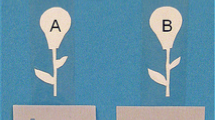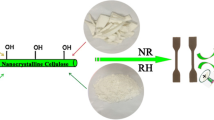Abstract
Cellulose was isolated from sugar beet chips, a by-product of sugar production, by wet chemistry. Further processing of the cellulose with a high-pressure homogeniser led to the disruption of cell walls into nanofibrils. Cellulose sheets obtained by casting and slow evaporation of water showed higher strength and stiffness when homogenised cellulose was used compared to unhomogenised cellulose. These cellulose sheets showed significantly better mechanical performance than Kraft paper tested for reference. The addition of cellulose nanofibrils to a polyvinyl alcohol and a phenol-formaldehyde matrix, respectively, demonstrated excellent reinforcement properties. The best mechanical performance was achieved for a composite with a phenol-formaldehyde resin content of 10%, which showed a tensile strength of 127 MPa, a modulus of elasticity of 9.5 GPa, and an elongation at break of 2.9%.







Similar content being viewed by others
References
Azizi Samir MAS, Alloin F, Paillet M, Dufresne A (2004) Tangling effect in fibrillated cellulose reinforced nanocomposites. Macromolecules 37:4313–4316
Bledzki AK, Gassan J (1999) Composites reinforced with cellulose based fibres. Prog Polym Sci 24:221–274
Bruce DM, Hobson RN, Farrent JW, Hepworth DG (2005) High-performance composites from low-cost plant primary cell walls. Comp A 36:1486–1493
Chawla KK (2001) Composite materials: science and engineering. Springer, New York
Dinand E, Chanzy H, Vignon MR (1996) Parenchymal cell cellulose from sugar beet pulp: preparation and properties. Cellulose 3:183–188
Dinand E, Chanzy H, Vignon MR (1999) Suspensions of cellulose microfibrils from sugar beet pulp. Food Hydrocolloids 13:275–283
Dufresne A, Cavaille J-Y, Vignon MR (1997) Mechanical behaviour of sheets prepared from sugar beet cellulose microfibrils. J Appl Polym Sci 64:1185–1194
Dufresne A (2006) Comparing the mechanical properties of high performance polymer nanocomposites from biological sources. J Nanosci Nanotechnol 6:322–330
Nishino T, Takano K, Nakamae K (1995) Elastic modulus of the crystalline regions of cellulose polymorphs. J Polym Sci B Polym Phys 33:1647–1651
Northolt MG, den Decker P, Picken SJ, Baltussen JJM, Schlatmann R (2005) The tensile strength of polymer fibres. Adv Polym Sci 178:1–108
Reddy N, Yang Y (2005) Biofibers from agricultural byproducts for industrial applications. Trends in Biotechnol 23:22–27
Zimmermann T, Pöhler E, Geiger T (2004) Cellulose fibrils for polymer reinforcement. Adv Eng Mater 6:754–761
Author information
Authors and Affiliations
Corresponding author
Rights and permissions
About this article
Cite this article
Leitner, J., Hinterstoisser, B., Wastyn, M. et al. Sugar beet cellulose nanofibril-reinforced composites. Cellulose 14, 419–425 (2007). https://doi.org/10.1007/s10570-007-9131-2
Received:
Accepted:
Published:
Issue Date:
DOI: https://doi.org/10.1007/s10570-007-9131-2




